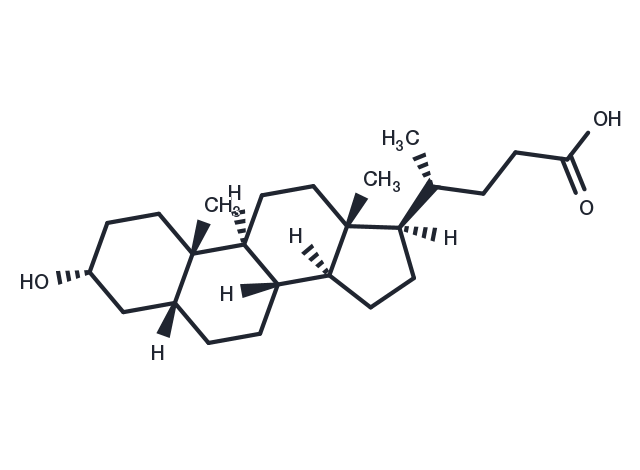Powder: -20°C for 3 years | In solvent: -80°C for 1 year
Lithocholic acid (3α-Hydroxy-5β-cholanic acid) is a bile acid formed from chenodeoxycholate by bacterial action, usually conjugated with glycine or taurine. It acts as a detergent to solubilize fats for absorption and is itself absorbed. It is used as cholagogue and choleretic.

| パッケージサイズ | 在庫状況 | 単価(税別) | |||
|---|---|---|---|---|---|
| サンプルについてお問い合わせ | |||||
| 500 mg | 在庫あり | ¥ 10,500 | |||
| 1 g | 在庫あり | ¥ 13,000 | |||
| 5 g | 在庫あり | ¥ 20,000 | |||
| 1 mL * 10 mM (in DMSO) | 在庫あり | ¥ 11,500 | |||
| 説明 | Lithocholic acid (3α-Hydroxy-5β-cholanic acid) is a bile acid formed from chenodeoxycholate by bacterial action, usually conjugated with glycine or taurine. It acts as a detergent to solubilize fats for absorption and is itself absorbed. It is used as cholagogue and choleretic. |
| In vitro | In a mouse cancer model induced by DMH (dimethylhydrazine), LCA effectively inhibits apoptosis almost completely in the precancerous colon. When administered to rodents, LCA and its conjugates cause intrahepatic cholestasis, a pathological state characterized by reduced bile flow and the accumulation of bile components in the liver and blood. Lithocholic acid activates the vitamin D receptor, inducing the expression of CYP3A, a cytochrome P450 enzyme that detoxifies LCA in the liver and intestines. |
| In vivo | Lithocholic acid exhibits tumor-promoting activity and inhibits mammalian DNA polymerase β with an IC50 of 15 μM. It causes cholestasis (cessation or obstruction of bile flow) within the liver. Furthermore, lithocholic acid activates the Pregnane X Receptor (PXR), and the severe liver damage induced by LCA can be mitigated by the activation of PXR. Additionally, lithocholic acid directly binds to the vitamin D receptor with a Ki of 29 μM, activating it with a sensitivity higher than that for other nuclear receptors (e.g., PXR, FXR), with a Ki of 30 μM. This activation offers protection from its toxic effects. |
| キナーゼ試験 | Competitive ligand binding assay.: Ligand binding is performed using lysates from COS-7 cells transfected with expression plasmids for VDR or RXRα. Binding is performed overnight at 4°C in lysate buffer with 0.71 nM (18 Ci/mmol) [3H]1,25(OH)2D3 and bile acid competitor. Unbound [3H]1,25(OH)2D3 is removed by adsorption to dextran-coated charcoal and the supernatant removed for scintillation counting. Ki values are calculated from a computer fit of competition curves from triplicate assays. |
| 別名 | 3α-Hydroxy-5β-cholanic acid |
| 分子量 | 376.57 |
| 分子式 | C24H40O3 |
| CAS No. | 434-13-9 |
Powder: -20°C for 3 years | In solvent: -80°C for 1 year
Ethanol: 44 mg/mL (116.8 mM)
DMSO: 55 mg/mL (146.05 mM)
H2O: < 1 mg/mL (insoluble or slightly soluble)
You can also refer to dose conversion for different animals. 詳細
bottom
Please see Inhibitor Handling Instructions for more frequently ask questions. Topics include: how to prepare stock solutions, how to store products, and cautions on cell-based assays & animal experiments, etc.
Lithocholic acid 434-13-9 Apoptosis Autophagy Metabolism Others Endogenous Metabolite FXR inhibit 3α-Hydroxy-5β-cholanic acid Inhibitor 3a-Hydroxy-5b-cholanic acid 3alpha-Hydroxy-5beta-cholanic acid inhibitor
